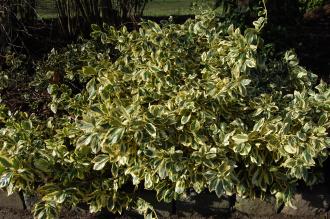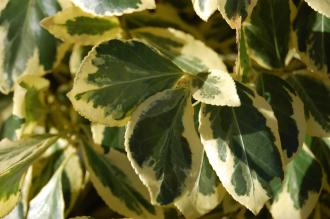
Euonymus japonicus ‘Aureopictus’ (08/02/2015, Kew Gardens, London)
Position: Full sun to shade
Flowering period: Summer
Soil: Moist, well drained
Eventual Height: 1.5m
Eventual Spread: 1.5m
Hardiness: 6b, 7a, 7b, 8a, 8b, 9a, 9b
Family: Celastraceae
Euonymus japonicus ‘Aureopictus’ is an evergreen shrub with a bushy habit. Its glossy dark green and cream coloured leaves are ovate with serrate margins, up to 6cm long and 3cm broad. Its green/ white flowers are small star shaped and up to 5mm across. Its fruit are small spherical pink fruits with orange seeds.
The species Euonymus japonicus, commonly known as Japanese spindle, is native to Japan, Korea and China.
The etymological root of the binomial name Euonymus is derived from the Greek eu ’good’ and onoma ’name’. Japonicus is derived from the Latin meaning ‘of Japan’.
The landscape architect may find Euonymus japonicus ‘Aureopictus’ useful as a variegated specimen shrub. It is suitable for use as evergreen hedging plant particularly in shady locations. It is drought tolerant once established. It is tolerant of maritime conditions.

Euonymus japonicus ‘Aureopictus’ Leaf (08/02/2015, Kew Gardens, London)
Ecologically, Euonymus japonicus flowers are attractive to pollinating insects. including bees and flies.
Euonymus japonicus prefers moist, fertile, well-drained soils. It tolerates most pH of soil. It will not tolerate waterlogged soil.
Euonymus japonicus requires little maintenance. If maintained as a hedge it may be cut in May and early autumn if necessary. If necessary it can be cut back heavily, also in May.

